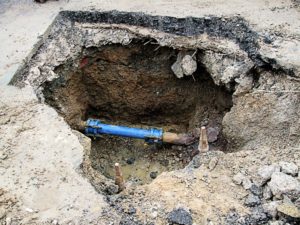
For millions, the lack of access to clean water is a life or death proposition. (Courtesy: Pexels)
Water is essential for life. Without it, the average person would die after four days.
In the aftermath of the Flint, Mich., water crisis, which saw 15 people die and more than 100,000 exposed to lead due to a forced switch of Flint’s water source from the Detroit Water Authority to the Flint River, questions about the health of the nation’s water infrastructure have filled political discussions. The Flint water crisis, which was caused in part due to aged, rusted delivery pipelines, exposed problems that many cities across the United States now have: a delivery infrastructure that has exceeded its utility age and a lack of funding and political will to effectively address the issues.
The long shadow inequality casts on policy making compounds this issue. “Black and Hispanic neighborhoods exhibited extraordinarily high rates of lead toxicity compared to white neighborhoods at the start of our study in 1995, in some cases with prevalence rates topping 90 percent of the child population,” Robert J. Sampson and Alix S. Winter wrote in their 2016 research paper “The Racial Ecology of Lead Poisoning: Toxic Inequality in Chicago Neighborhoods, 1995-2013.”
“Black disadvantage in particular is pronounced not only relative to whites but even relative to Hispanics in every year from 1995-2013. The profound heterogeneity in the racial ecology of what we call toxic inequality is partially attributable to socioeconomic factors, such as poverty and education, and to housing-related factors, such as unit age, vacancy and dilapidation. But controlling these factors, neighborhood prevalence rates of elevated BLL (Blood Lead Levels) remain closely linked to racial and ethnic segregation.”
In cities that have limited resources for infrastructure repairs, the picking of winners and losers has historically fallen upon racial biases, with minority neighborhoods and communities being overlooked in favor for more-affluent communities. As pointed out by the research paper, as white neighborhoods are more likely to gentrify and receive infrastructure repairs than nonwhite neighborhoods, there is a greater risk of lead exposure and prolonged health complications that comes with the water made available in Black and Hispanic neighborhoods.
With the Centers for Disease Control and Prevention confirming that there is no safe identified level of lead for the blood, and with minuscule amounts of lead being shown to affect intelligence, attention span and academic achievement, the question of the safety of the nation’s water has never been so pertinent. With most of the nation’s water-delivery infrastructure compromised and in need of replacement, questions of how these repairs can be made in this current political climate and if these repairs will be equitably allocated remain concerns of both high importance and high complexity
“Racism in regards to water access was certainly a factor of our past. Just look at some places in the South, especially along the Mississippi Delta, where you have white communities side by side with Black communities but the white communities have adequate water infrastructure and the Black communities do not,” said Cecil Corbin-Mark, Deputy Director of WE ACT. “That is not the result of the Black communities saying we don’t want water infrastructure, it is a legacy of racial discrimination. If you travel in indigenous land or heavily Latino communities in the Rio Grande Valley of Texas, you can also see the disparity in water infrastructure.”
Flint
To a certain extent, Flint is your prototypical Northern industrial city. It is the former home of many of General Motor’s facilities, including its headquarters and the majority of its manufacturing plants. Prior to the deindustrialization of the 1960s, Flint was a wealthy city within a stone’s toss of the wealthiest city in the United States during the early part of the 20th century, Detroit.
The downturn of the nation’s industrial base, along with “white flight” and the 1973 oil crisis — which saw a popular switching from American-made car to fuel-efficient Japanese cars — threw Flint into a debt spiral. The result of this was two state-declared financial emergencies.
It was under the second emergency that the water crisis, which has to date led to 17 criminal indictments, several lawsuits, the resignation of a litany of state officials and a federal state of emergency, happened. In an attempt to save money, the state-approved emergency financial manager for Flint approved the adoption of an emergency plan to draw water from the Flint River as the primary water delivery scheme for the city while Flint’s own pipeline to Lake Huron was being completed. Before this, Flint received its water from Detroit, which sourced it from the Detroit River and Lake Huron.
Unfortunately, no one took the time to consider if switching the water supply would change the delivered water’s composition. While the water was treated, it was found that the water was more corrosive than the water received from Detroit. This was the result of bacterial growth from fertilizer and pesticide runoffs and it caused exposed lead in the city’s pipes to bleed into the water.
It would take two years and a MSNBC investigation for the state to admit there was a problem.
While the governor himself has dodged criminal responsibility for now, the crisis gave the Republican administration a black eye. Michigan Health and Human Services Director Nick Lyon and Chief Medical Executive Eden Wells are among those who have been arrested on charges that include involuntary manslaughter, misconduct in office, obstruction of justice and providing false testimony to a special agent.
“We’re getting it right,” Michigan Attorney General Bill Schuette said during a meeting with the Detroit Free Press editorial board. “There are voices out there who would like Flint to go away, that it might be inconvenient and Flint should be swept under the rug and there are voices that view Flint as as chessboard and want to see who can take advantage. Both of those voices are incredibly callous.”
Schuette pointed out that racism may have had a role in what happened in Flint. “I think about the Flint where I used to play sports when I’d come from Midland and it was basically all white,” he said. “I think about all those things and I think about my sister [who adopted two mixed-race children] and how it broadened my perspective. I think about all those things when I drive down the road and go into Flint and think about these charges and meet with these people and try to listen.”
Flint is a majority-Black city. The loss of manufacturing jobs led to a mass exodus of the city’s white residents, leaving behind a city that is 56.6-percent African American, 41.2-percent impoverished and with a median household income of $24,862, 50.1 percent of the state’s average of $49,576.

There are approximately 240,000 water main breaks in the United States every year. (Courtesy: Flickr)
A Crumbling Infrastructure
The nation’s one million miles of drinking water pipes were laid during the first half of the 20th century, largely in massive public works projects. While the quality of the drinking water is regarded as being high, the pipe infrastructure carrying this water to the tap is in a state of disrepair, with most of the pipelines having reached the end of their expected lifespans. This results in an estimated 240,000 water main breaks per year in this country.
The difficulty in bringing the nation’s pipes up to date is typically a monetary one. For most communities, repairs to the water infrastructure is funded by the delivery rate the local community charges water users, along with state funding and federal loan programs such as the Drinking Water State Revolving Fund.
Following the recent Great Recession, the states and local governments deemphasized infrastructure in order to deal with falling tax revenues. From 2009 to 2014, for example, capital spending for drinking water and wastewater infrastructure dropped 22 percent. While federal legislation in 2014 and 2016 has allocated up to $1 billion in credit assistance and $2 billion in water infrastructure investment, it is estimated it will take about $1 trillion over the next 25 years to bring the nation’s water infrastructure up to speed.
The condition of the national water system, as it stands today, is responsible for the average loss of over six billion gallons of drinking water from leakage per day.
Race and Picking Winners
The municipal delivery system, however, is only the public half of the national water delivery system. The other half is what happens after the water crosses the water meter. The responsibility of property owners, the conditions of these pipes — particularly in low-income or impoverished areas — can make a significant difference in the quality of the delivered water.
Prior to efforts in the 1970s to remove the substance, lead was a popular additive due to its molecular density. Lead regularly appeared in paints, plastics, piping, woodwork and other building supplies across the country. In older properties where these lead-based products have not been removed, such as inner-city low-income Black housing, young children may come in contact with this toxic substance daily.
“Right now, most middle-class white families feel relatively immune from the dangers of lead, although the gentrification of old neighborhoods and the renovation of old homes can still expose their children to dangerous levels of lead dust from the old paint on those walls,” David Rosner and Gerald Markowitz wrote for Mother Jones. “However, economically and politically vulnerable Black and Hispanic children, many of whom inhabit dilapidated older housing, still suffer disproportionately from the devastating effects of the toxin. This is the meaning of institutional racism in action today.”
While there is less “winner-picking” involved in the allocation of infrastructure funding today, more affluent or “gentrified” neighborhoods have been the neighborhoods least likely to be affected by lead poisoning. Not only were these communities more likely to receive updates to their infrastructure and receive more attention, such as regular lead testing, the increased demand to live in these areas compelled property owners to make critical improvements to their properties. Owners in non-gentrified properties typically can get away with ignoring these repairs and replacements by offering a cheaper rent.
The net effect of all of this adds up to health crisis for the Black and Hispanic communities. The CDC projects that 11.2 percent of all Black children and 4 percent of Mexican-American children have lead poisoning, compared to just 2.3 percent of white children. With more than half of the residents living within 1.86 miles of toxic waste facilities being Black and with Blacks being almost twice as likely as whites to live within the fence line zone of an industrial facility, African-Americans are uniquely challenged with the health consequences of unhealthy water.
Privatization and Other Options
Finding solutions to fix this may be difficult, primarily because there is not the political will to do it. In 2015, for example, Maryland’s Secretary of Housing, Community and Development Kenneth Holt told an audience at the Maryland Association of Counties that a mother could fake a lead poisoning test for her child by putting a lead fishing weight in the child’s mouth before the test. He made the statement, falsely suggesting that the potential positive test would make a landlord liable for providing the child with housing until the age of 18.
Maryland state law only makes the property owner liable for providing safe lodgings until the lead abatement concludes and Holt himself admitted that he was not speaking from evidence but from what a developer told him was possible.
Resolving the drinking water problem will be a costly, difficult proposition that will leave little for politicians to build political capital on. However, finding a viable solution is a life-or-death proposition.
“Water isn’t very sexy,” Nick Danby wrote for the Harvard Political Review. “Sure, it’s necessary for life, and sometimes threatens life, but there’s no political appeal. Unemployment, terrorism, unions, taxes — those are just a small smorgasbord of hot-button issues that make our partisan and politically charged brains tingle, while water’s controversies merely bore us. The problem, however, is that if our ignorance of water’s contentious situation continues, the four aforementioned political topics will become obsolete — and so will we.”
One suggested possibility is to make the water-delivery system private. In 2014, former President Barack Obama examined the possibility of partnerships between public agencies and private companies to improve the infrastructure problem. Privatization would take this one step farther by allowing municipalities to lease access to the water-delivery infrastructure to private entities, who would then be responsible for any needed upgrades or repairs. These entities would then collect water usage fees directly from the customer.
The challenge in this proposition is whether we are willing to put life-and-death matters into the hands of a business where the first priority is the bottom line.
Whatever solution is found to address this problem, it is important that it is discovered soon and applied quickly. Water is critical for life; only air is more important. The consequences of not being able to have ready access to clean water is one that must be considered and taken seriously in policy planning and in discussions over funding priorities.
For an entire subsection of Americans, the lack of access to safe water means a life subject to crippling physical and mental limitations, all because a politician did not want to spend money on what cannot be seen.


